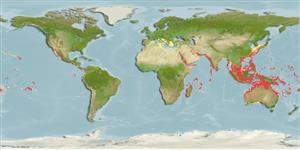Common names from other countries
Environment: milieu / climate zone / depth range / distribution range
Οικολογία
Υφαλόφιλο(α); εύρος βάθους 1 - 110 m (Ref. 101020). Tropical
Indo-Pacific and the Mediterranean: from East and South Africa, to western Polynesia; north to Japan and south to central Queensland and New Caledonia.
Length at first maturity / Μέγεθος / Βάρος / Age
Maturity: Lm ? range ? - ? cm Max length : 4.0 cm SHL αρσενικό/απροσδιόριστο; (Ref. 349); common length : 3.0 cm SHL αρσενικό/απροσδιόριστο; (Ref. 349)
Sometimes found in local markets (Ref. 349). Shallow subtidal zones (Ref. 349). Most Nassariidae are omnivores and facultative scavengers (Ref. 108572).
Life cycle and mating behavior
Γεννητική Ωρίμανση | Αναπαραγωγή | Γεννοβολία | Αβγά | Γονιμότητα | Προνύμφες
This species is a non-broadcast spawner. Life cycle does not include trocophore stage. Also Ref. 833.
Poutiers, J.M. 1998. (Ref. 349)
IUCN Red List Status (Ref. 130435)
CITES status (Ref. 108899)
Not Evaluated
Not Evaluated
Human uses
| FishSource |
Εργαλεία
Περισσότερες πληροφορίες
Age/Size
Αύξηση
Length-weight
Length-length
Μορφολογία
Προνύμφες
Αφθονία
Διαδικτυακές πηγές
Estimates based on models
Preferred temperature
(Ref.
115969): 23.6 - 29.1, mean 28 (based on 2396 cells).
Vulnerability
Low vulnerability (10 of 100).
Price category
Unknown.
